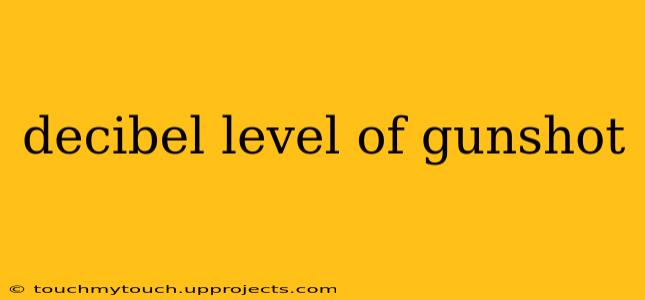The decibel level of a gunshot is not a single, fixed number. It varies dramatically depending on several factors, making a precise answer impossible without specifying these variables. This article will delve into the complexities of gunshot sound, exploring the contributing factors and the potential dangers of firearm noise exposure.
Factors Affecting Gunshot Decibel Levels
Several key elements influence how loud a gunshot is:
-
Type of firearm: Handguns generally produce lower decibel levels than rifles or shotguns. The caliber of the ammunition also plays a significant role; larger calibers typically generate louder sounds. The design of the firearm itself, including the barrel length and muzzle device, impacts the noise output.
-
Ammunition type: Different types of ammunition, even within the same caliber, produce varying decibel levels. Factors like powder type and bullet weight contribute to the overall sound pressure.
-
Environment: The environment significantly affects the perceived loudness. Shooting outdoors in an open space will result in less sound reflection compared to shooting indoors or in a confined area like a shooting range. The terrain and surrounding objects can also influence sound propagation.
-
Distance from the firearm: The closer you are to the gunshot, the higher the decibel level you'll experience. Sound intensity decreases with distance, following an inverse square law.
Typical Decibel Ranges for Gunshots
While an exact number is elusive, studies and measurements suggest that gunshot decibel levels typically range from 140 to 175 dB. This places them well above the threshold of pain (approximately 120 dB) and poses significant risks to hearing health. Some particularly powerful firearms and ammunition can even exceed 180 dB.
Understanding the Damage:
Exposure to sounds at these levels can cause immediate and long-term hearing damage. Even a single exposure to a gunshot at close range can lead to:
- Temporary Threshold Shift (TTS): A temporary reduction in hearing sensitivity.
- Permanent Threshold Shift (PTS): Permanent hearing loss, potentially resulting in tinnitus (ringing in the ears) and hyperacusis (increased sensitivity to sound).
Hearing Protection: A Necessity
Given the potential for serious hearing damage, wearing appropriate hearing protection is absolutely crucial when handling firearms. This includes:
- Hearing Protection Rating (HPR): Look for hearing protection with a high Noise Reduction Rating (NRR) to ensure adequate attenuation of the gunshot sound.
- Types of Hearing Protection: Electronic earmuffs allow communication while providing hearing protection, while foam earplugs offer a cost-effective and readily available option. Consider using both for maximum protection.
Conclusion: Safety and Responsibility
Understanding the decibel levels associated with gunshots and the potential dangers they pose is essential for responsible firearm handling and safe practice. Always prioritize hearing protection and maintain a safe distance from firearms during discharge. Regular hearing checkups are also recommended for individuals who frequently handle firearms. Remember, protecting your hearing is an investment in your long-term well-being.
